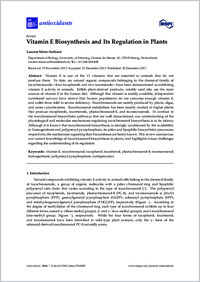Vitamin E biosynthesis and its regulation in plants
- Mène-Saffrané, Laurent Department of Biology, University of Fribourg, Switzerland
-
25.12.2017
Published in:
- Antioxidants. - 2017, vol. 7, no. 1, p. 2
English
Vitamin E is one of the 13 vitamins that are essential to animals that do not produce them. To date, six natural organic compounds belonging to the chemical family of tocochromanols—four tocopherols and two tocotrienols—have been demonstrated as exhibiting vitamin E activity in animals. Edible plant-derived products, notably seed oils, are the main sources of vitamin E in the human diet. Although this vitamin is readily available, independent nutritional surveys have shown that human populations do not consume enough vitamin E, and suffer from mild to severe deficiency. Tocochromanols are mostly produced by plants, algae, and some cyanobacteria. Tocochromanol metabolism has been mainly studied in higher plants that produce tocopherols, tocotrienols, plastochromanol-8, and tocomonoenols. In contrast to the tocochromanol biosynthetic pathways that are well characterized, our understanding of the physiological and molecular mechanisms regulating tocochromanol biosynthesis is in its infancy. Although it is known that tocochromanol biosynthesis is strongly conditioned by the availability in homogentisate and polyprenyl pyrophosphate, its polar and lipophilic biosynthetic precursors, respectively, the mechanisms regulating their biosyntheses are barely known. This review summarizes our current knowledge of tocochromanol biosynthesis in plants, and highlights future challenges regarding the understanding of its regulation
- Faculty
- Faculté des sciences et de médecine
- Department
- Département de Biologie
- Language
-
- English
- Classification
- Biological sciences
- License
-
License undefined
- Identifiers
-
- RERO DOC 308968
- DOI 10.3390/antiox7010002
- Persistent URL
- https://folia.unifr.ch/unifr/documents/306473
Statistics
Document views: 115
File downloads:
- pdf: 189
